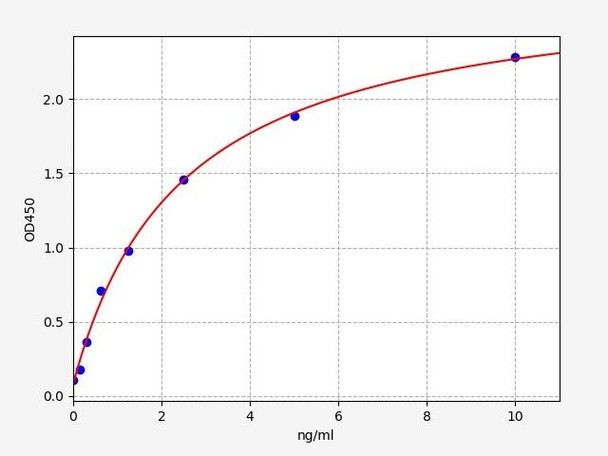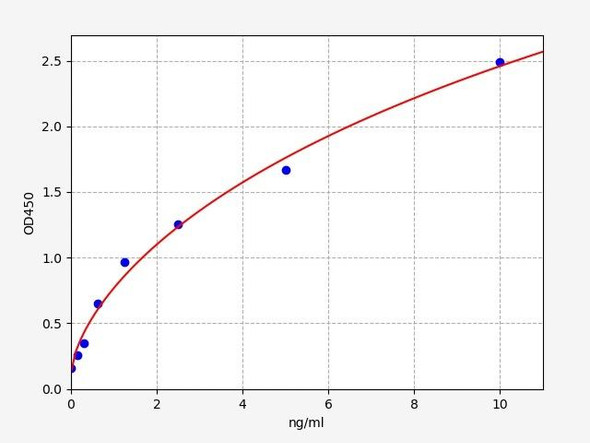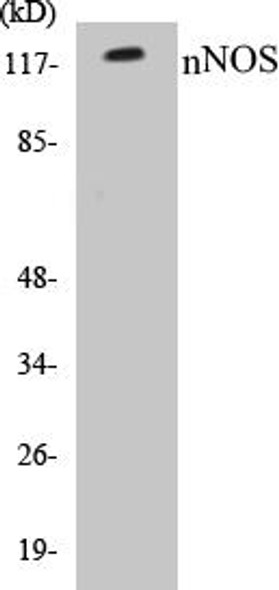Rat nNOS ELISA Kit (RTFI00083)
- SKU:
- RTFI00083
- Product Type:
- ELISA Kit
- Size:
- 96 Assays
- Uniprot:
- P29476
- Sensitivity:
- 0.094ng/ml
- Range:
- 0.156-10ng/ml
- ELISA Type:
- Sandwich
- Synonyms:
- NOS1, nNOS, bNOS, brain, Constitutive NOS, IHPS1, Neuronal NOS, nitric oxide synthase 1, neuronal, N-NOS, NOS type I, NOS, Peptidyl-cysteine S-nitrosylase NOS1
- Reactivity:
- Rat
Description
Rat nNOS ELISA Kit
The Rat nNOS (Neuronal Nitric Oxide Synthase) ELISA Kit is a powerful tool for the precise measurement of nNOS levels in rat samples such as serum, plasma, and tissue lysates. With exceptional sensitivity and specificity, this kit delivers consistent and reliable results for a variety of research applications.nNOS is a key enzyme involved in the production of nitric oxide, a critical signaling molecule in the nervous system. Its dysregulation has been linked to various neurological disorders, making it an important biomarker for understanding these conditions and developing new treatment strategies.
Equipped with easy-to-follow instructions and all necessary components, the Rat nNOS ELISA Kit is an indispensable resource for researchers investigating the role of nNOS in neuronal function and pathology. Trust in this kit to provide accurate and insightful data for your experiments.
| Product Name: | Rat nNOS ELISA Kit |
| Product Code: | RTFI00083 |
| Size: | 96 Assays |
| Target: | Rat NOS1/nNOS |
| Alias: | NOS1, nNOS, bNOS, brain, Constitutive NOS, IHPS1, Neuronal NOS, nitric oxide synthase 1, neuronal, N-NOS, NOS type I, NOS, Peptidyl-cysteine S-nitrosylase NOS1 |
| Reactivity: | Rat |
| Detection Method: | Sandwich ELISA, Double Antibody |
| Sensitivity: | 0.094ng/ml |
| Range: | 0.156-10ng/ml |
| Storage: | 4°C for 6 months |
| Note: | For Research Use Only |
| Recovery: | Matrices listed below were spiked with certain level of Rat NOS1/nNOS and the recovery rates were calculated by comparing the measured value to the expected amount of Rat NOS1/nNOS in samples. | ||||||||||||||||
| |||||||||||||||||
| Linearity: | The linearity of the kit was assayed by testing samples spiked with appropriate concentration of Rat NOS1/nNOS and their serial dilutions. The results were demonstrated by the percentage of calculated concentration to the expected. | ||||||||||||||||
| |||||||||||||||||
| Intra-Assay: | CV <8% | ||||||||||||||||
| Inter-Assay: | CV <10% |
| Uniprot: | P29476 |
| UniProt Protein Function: | nNOS: nitric oxide synthase 1, neuronal form. Produces nitric oxide which is a messenger molecule with diverse functions and displays many properties of a neurotransmitter in the brain and peripheral nervous system. May be an effector enzyme for the dystrophin complex. Four alternatively spliced isoforms have been described. |
| UniProt Protein Details: | Protein type:EC 1.14.13.39; Amino Acid Metabolism - arginine and proline; Oxidoreductase Cellular Component: azurophil granule; caveola; cytoplasm; cytoskeleton; cytosol; dendrite; dendritic spine; lipid raft; membrane; mitochondrial outer membrane; mitochondrion; nuclear membrane; nucleus; perinuclear region of cytoplasm; photoreceptor inner segment; plasma membrane; postsynaptic density; protein complex; sarcolemma; sarcoplasmic reticulum; sarcoplasmic reticulum membrane; synapse; T-tubule; vesicle membrane; Z disc Molecular Function:amino acid binding; ATPase binding; cadmium ion binding; calmodulin binding; enzyme binding; FAD binding; FMN binding; heme binding; iron ion binding; NADP binding; nitric-oxide synthase activity; protein binding; protein homodimerization activity; sodium channel regulator activity Biological Process: aging; arginine catabolic process; behavioral response to cocaine; exogenous drug catabolic process; female pregnancy; multicellular organismal response to stress; negative regulation of apoptosis; negative regulation of blood pressure; negative regulation of calcium ion transport; negative regulation of cell proliferation; negative regulation of heart contraction; negative regulation of hydrolase activity; negative regulation of insulin secretion; negative regulation of peptidyl-serine phosphorylation; negative regulation of potassium ion transport; negative regulation of serotonin uptake; negative regulation of vasoconstriction; nitric oxide biosynthetic process; nitric oxide mediated signal transduction; peptidyl-cysteine S-nitrosylation; positive regulation of guanylate cyclase activity; positive regulation of histone acetylation; positive regulation of transcription from RNA polymerase II promoter; positive regulation of transcription, DNA-dependent; positive regulation of vasodilation; reduction of cytosolic calcium ion concentration; regulation of heart contraction; regulation of neurogenesis; regulation of sensory perception of pain; regulation of sodium ion transport; response to activity; response to estrogen stimulus; response to ethanol; response to heat; response to hypoxia; response to lead ion; response to lipopolysaccharide; response to nicotine; response to nutrient levels; response to organic cyclic substance; response to organic nitrogen; response to peptide hormone stimulus; response to vitamin E; striated muscle contraction |
| NCBI Summary: | enzyme that catalyzes the production of nitric oxide [RGD, Feb 2006] |
| UniProt Code: | P29476 |
| NCBI GenInfo Identifier: | 16258811 |
| NCBI Gene ID: | 24598 |
| NCBI Accession: | NP_434686.1 |
| UniProt Secondary Accession: | P29476,P70594, |
| UniProt Related Accession: | P29476 |
| Molecular Weight: | 164,430 Da |
| NCBI Full Name: | nitric oxide synthase, brain |
| NCBI Synonym Full Names: | nitric oxide synthase 1 |
| NCBI Official Symbol: | Nos1 |
| NCBI Official Synonym Symbols: | bNOS |
| NCBI Protein Information: | nitric oxide synthase, brain |
| UniProt Protein Name: | Nitric oxide synthase, brain |
| UniProt Synonym Protein Names: | BNOS; Constitutive NOS; NC-NOS; NOS type I; Neuronal NOS; N-NOS; nNOS; Peptidyl-cysteine S-nitrosylase NOS1 |
| Protein Family: | Nitric oxide synthase |
| UniProt Gene Name: | Nos1 |
| UniProt Entry Name: | NOS1_RAT |
| Step | Procedure |
| 1. | Set standard, test sample and control (zero) wells on the pre-coated plate respectively, and then, record their positions. It is recommended to measure each standard and sample in duplicate. Wash plate 2 times before adding standard, sample and control (zero) wells! |
| 2. | Aliquot 0.1ml standard solutions into the standard wells. |
| 3. | Add 0.1 ml of Sample / Standard dilution buffer into the control (zero) well. |
| 4. | Add 0.1 ml of properly diluted sample ( Human serum, plasma, tissue homogenates and other biological fluids.) into test sample wells. |
| 5. | Seal the plate with a cover and incubate at 37°C for 90 min. |
| 6. | Remove the cover and discard the plate content, clap the plate on the absorbent filter papers or other absorbent material. Do NOT let the wells completely dry at any time. Wash plate X2. |
| 7. | Add 0.1 ml of Biotin- detection antibody working solution into the above wells (standard, test sample & zero wells). Add the solution at the bottom of each well without touching the side wall. |
| 8. | Seal the plate with a cover and incubate at 37°C for 60 min. |
| 9. | Remove the cover, and wash plate 3 times with Wash buffer. Let wash buffer rest in wells for 1 min between each wash. |
| 10. | Add 0.1 ml of SABC working solution into each well, cover the plate and incubate at 37°C for 30 min. |
| 11. | Remove the cover and wash plate 5 times with Wash buffer, and each time let the wash buffer stay in the wells for 1-2 min. |
| 12. | Add 90 µL of TMB substrate into each well, cover the plate and incubate at 37°C in dark within 10-20 min. (Note: This incubation time is for reference use only, the optimal time should be determined by end user.) And the shades of blue can be seen in the first 3-4 wells (with most concentrated standard solutions), the other wells show no obvious color. |
| 13. | Add 50 µL of Stop solution into each well and mix thoroughly. The color changes into yellow immediately. |
| 14. | Read the O.D. absorbance at 450 nm in a microplate reader immediately after adding the stop solution. |
When carrying out an ELISA assay it is important to prepare your samples in order to achieve the best possible results. Below we have a list of procedures for the preparation of samples for different sample types.
| Sample Type | Protocol |
| Serum: | If using serum separator tubes, allow samples to clot for 30 minutes at room temperature. Centrifuge for 10 minutes at 1,000x g. Collect the serum fraction and assay promptly or aliquot and store the samples at -80°C. Avoid multiple freeze-thaw cycles. If serum separator tubes are not being used, allow samples to clotovernight at 2-8°C. Centrifuge for 10 minutes at 1,000x g. Removeserum and assay promptly or aliquot and store the samples at-80°C. Avoid multiple freeze-thaw cycles. |
| Plasma: | Collect plasma using EDTA or heparin as an anti-coagulant. Centrifuge samples at 4°C for 15 mins at 1000 × g within 30 mins of collection. Collect the plasma fraction and assay promptly or aliquot and store the samples at -80°C. Avoid multiple freeze-thaw cycles.Note: Over haemolysed samples are not suitable for use with this kit. |
| Urine & Cerebrospinal Fluid: | Collect the urine (mid-stream) in a sterile container, centrifuge for 20 mins at 2000-3000 rpm. Remove supernatant and assay immediately. If any precipitation is detected, repeat the centrifugation step. A similar protocol can be used for cerebrospinal fluid. |
| Cell Culture Supernatant: | Collect the cell culture media by pipette, followed by centrifugation at 4°C for 20 mins at 1500 rpm. Collect the clear supernatant and assay immediately. |
| Cell Lysates: | Solubilize cells in lysis buffer and allow to sit on ice for 30 minutes. Centrifuge tubes at 14,000 x g for 5 minutes to remove insoluble material. Aliquot the supernatant into a new tube and discard the remaining whole cell extract. Quantify total protein concentration using a total protein assay. Assay immediately or aliquot and store at ≤ -20°C. |
| Tissue Homogenates: | The preparation of tissue homogenates will vary depending upon tissue type. Rinse tissue with 1X PBS to remove excess blood & homogenizein 20ml of 1X PBS (including protease inhibitors) and store overnight at ≤ -20°C. Two freeze-thaw cycles are required to break the cell membranes. To further disrupt the cell membranes you can sonicate the samples. Centrifuge homogenates for 5 mins at 5000xg. Remove the supernatant and assay immediately or aliquot and store at -20°C or-80°C. |
| Tissue Lysates: | Rinse tissue with PBS, cut into 1-2 mm pieces, and homogenize with a tissue homogenizer in PBS. Add an equal volume of RIPA buffer containing protease inhibitors and lyse tissues at room temperature for 30 minutes with gentle agitation. Centrifuge to remove debris. Quantify total protein concentration using a total protein assay. Assay immediately or aliquot and store at ≤ -20 °C. |
| Breast Milk: | Collect milk samples and centrifuge at 10,000 x g for 60 min at 4°C. Aliquot the supernatant and assay. For long term use, store samples at -80°C. Minimize freeze/thaw cycles. |






